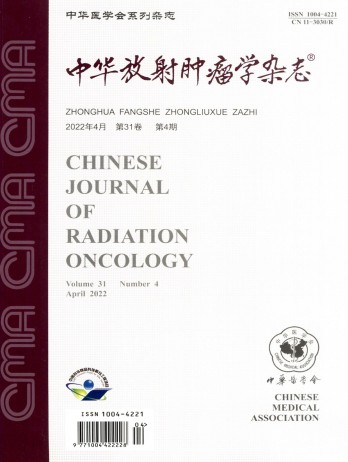Silencing lncRNA GIHCG increases radiosensitivity of glioma cells by up-regulating miR-146a-3p
引用次数: 0
Abstract
Objective To investigate the effect of lncRNA GIHCG on the radiosensitivity of glioma cells and its mechanism. Methods The expression levels of GIHCG and miR-146a-3p in human brain normal glial cells HEB and glioma cell lines U251, A172, SHG139 and U87 were quantitatively measured by qRT-PCR assay. U251 and SHG139 cells were used for subsequent experiment. After silencing the expression of GIHCG or overexpressing miR-146a-3p in U251 and SHG139 cells, cell proliferation was detected by MTT assay, cell apoptosis was detected by flow cytometry, cell radiosensitivity was detected by colony formation assay and the expression levels of CDK1, CyclinD1, Bcl-2 and Bax proteins were measured by Western blot. The bioinformatics software predicted the presence of a binding site for GIHCG and miR-146a-3p. Dual luciferase reporter gene assay and qRT-PCR assay were adopted to verify the targeting relationship between GIHCG and miR-146a-3p. Results Compared with HEB cells, the expression of GIHCG was significantly up-regulated in glioma U87, U251, A172 and SHG139 cells (all P<0.05), whereas that of miR-146a-3p was remarkably down-regulated (P<0.05). Silencing GIHCG expression or overexpression of miR-146a-3p significantly decreased the U251 and SHG139 cell survival rate, survival fraction and the expression of CDK1, CyclinD1 and Bcl-2 proteins (all P<0.05), whereas considerably increased the apoptotic rate and expression of Bax protein (both P<0.05). GIHCG performed targeted negative regulation of miR-146a-3p expression in U251 and SHG139 cells and inhibition of miR-146a-3p expression reversed the effect of silencing GIHCG on proliferation, apoptosis and radiosensitivity of glioma cells. Conclusion Silencing GIHCG expression up-regulates the expression of miR-146a-3p, thereby enhancing the radiosensitivity of glioma cells. Key words: Glioma; lncRNA GIHCG; miR-146a-3p gene; Radiosensitivity沉默lncRNA GIHCG通过上调miR-146a-3p增加胶质瘤细胞的放射敏感性
目的探讨lncRNA-GIHCG对胶质瘤细胞放射敏感性的影响及其机制。方法采用qRT-PCR方法定量检测人脑正常胶质细胞HEB和胶质瘤细胞系U251、A172、SHG139和U87中GIHCG和miR-146a-3p的表达水平。U251和SHG139细胞用于随后的实验。在U251和SHG139细胞中沉默GIHCG的表达或过表达miR-146a-3p后,通过MTT法检测细胞增殖,通过流式细胞术检测细胞凋亡,通过集落形成法检测细胞放射敏感性,并通过Western印迹测定CDK1、CyclinD1、Bcl-2和Bax蛋白的表达水平。生物信息学软件预测了GIHCG和miR-146a-3p结合位点的存在。采用双荧光素酶报告基因检测和qRT-PCR检测来验证GIHCG与miR-146a-3p之间的靶向关系。结果与HEB细胞相比,胶质瘤U87、U251、A172和SHG139细胞中GIHCG的表达显著上调(均P<0.05),而miR-146a-3p的表达显著下调(P<0.05),CyclinD1和Bcl-2蛋白(均P<0.05),而显著增加了胶质瘤细胞的凋亡率和Bax蛋白的表达(均<0.05)。GIHCG对U251和SHG139细胞的miR-146a-3p表达进行了靶向负调控,抑制miR-146a-3p表达逆转了GIHCG沉默对胶质瘤细胞增殖、凋亡和放射敏感性的影响。结论GIHCG的沉默表达上调了miR-146a-3p的表达,从而增强了胶质瘤细胞的放射敏感性。关键词:胶质瘤;lncRNA-GIHCG;miR-146a-3p基因;辐射敏感性
本文章由计算机程序翻译,如有差异,请以英文原文为准。
求助全文
约1分钟内获得全文
求助全文
来源期刊
自引率
0.00%
发文量
6375
期刊介绍:
The Chinese Journal of Radiation Oncology is a national academic journal sponsored by the Chinese Medical Association. It was founded in 1992 and the title was written by Chen Minzhang, the former Minister of Health. Its predecessor was the Chinese Journal of Radiation Oncology, which was founded in 1987. The journal is an authoritative journal in the field of radiation oncology in my country. It focuses on clinical tumor radiotherapy, tumor radiation physics, tumor radiation biology, and thermal therapy. Its main readers are middle and senior clinical doctors and scientific researchers. It is now a monthly journal with a large 16-page format and 80 pages of text. For many years, it has adhered to the principle of combining theory with practice and combining improvement with popularization. It now has columns such as monographs, head and neck tumors (monographs), chest tumors (monographs), abdominal tumors (monographs), physics, technology, biology (monographs), reviews, and investigations and research.

 求助内容:
求助内容: 应助结果提醒方式:
应助结果提醒方式:


